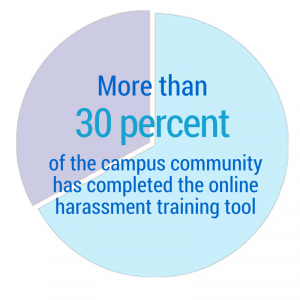This story is the third in a series examining the actions Lehigh University is taking to address campus climate as a result of the voluntary resolution agreement with the OCR. Read part one here. Read part two here.
In November 2006, a skinned deer head was left on the steps of Lehigh’s Umoja House, a residential space established to enhance the campus atmosphere for underrepresented students of color. This resulted in outrage from the community, including a student protest group called The Movement, and yet little change.
History repeated itself almost exactly seven years earlier. On the morning of Nov. 6, 2013, the 28 students living in the same house awoke to find their home splattered with egg yolks and emblazoned with racial slurs in red spray paint.
Occurring just a few weeks after a student-organized protest called From Beneath the Rug, the vandalism sparked a growing anger on campus. More than 1,600 students, faculty and staff gathered at the university’s flagpole for a rally for unity that evening. It brought the Lehigh community together to focus on the issues of diversity and inclusion on campus.
It wasn’t until the second incident – seven years later – did the Office of Civil Rights become involved with Lehigh’s growing issue of campus climate. After filed reports and an investigation, Lehigh entered a voluntary resolution agreement with OCR in September 2014. Since then, the university has been working on completing the action steps outlined in the plan and more in order to ameliorate its campus culture.
“I think anything that helps us change and be better is a positive,” said Karen Salvemini, Lehigh’s newly hired equal opportunity compliance coordinator. “While the situation itself might not have been a positive experience, the voluntary resolution agreement (has been positive) in terms of what it forced us to do in assessing our own programs and what we’re offering and different things that we can be doing, or things that we were thinking about doing that we hadn’t put into place yet.”
However, other members of the Lehigh community are skeptical as to whether these changes will be sustainable, and some even question whether the changes would exist if not for the Umoja House vandalism last year.
“We need to define diversity and inclusion…We can’t be ambiguous because then we are not solving any issues,” Ralph Jean-Noel, ’15, said. “We are just covering a deep wound with a bandage when what we really need is a reconstructive surgery.”
Harassment policy revision
Lehigh’s harassment policy has not seen a major revision process in over 10 years. Adopted in 2002, the policy has only recently been revised as a requirement of the university’s voluntary resolution agreement with the Office of Civil Rights.
The new policy was approved at a special faculty meeting in March and will go before the board of trustees for final review in June. “If the policy is approved at that time, the campus community can expect additional training on the specific details of the policy during the fall 2015 semester,” said an email sent to the Lehigh community by President Kevin Clayton and Provost Pat Farrell on May 1.
Freddy Coleman, ‘17, is one of the students who sat on the harassment policy review committee. He said he wanted to make sure the harassment reporting and investigation process was short but informative for students.
“As college students we’re only going to be here for a certain amount of time and the administrators are there forever,” he said. His role on the committee included making sure the undergraduate student perspective was heard.
He said the revision process resulted in some items being cut out if they didn’t make sense, or Lehigh didn’t follow them well. Coleman said the policy revision was “because (Lehigh has) to do it, with the OCR agreement.”
Jennifer Swann, a tri-chair of the Council for Equity and Community as well as a professor in the biological sciences department, said that many members of CEC were on the harassment policy review committee, including Heather Hosfeld, assistant general counsel and one of the leaders of the policy revision.
“There were gaps in some parts of the policy that were strengthened,” Swann said. She said that the bulk of the faculty are not paying as much attention to diversity as they could be.
Jean-Noel said policies need to be revisited on a constant basis and approved by students, faculty and staff.
“To be honest it represents what always happens when these issues come up or occur at Lehigh – a policy or statement is put out and set in stone with barely any space for changes to adapt with changing times,” he said.
Coleman echoed this sentiment. He said it was disappointing that the policy didn’t see any major revisions for over a decade, but he is happy there is change starting.
“What I’m looking forward to is will this actually work when it’s actually in place?” Coleman asked. “Will students feel like they’re being fairly served the right justice for whatever issue that they experience on campus?”
Salvemini said a major overhaul of a policy is a time-consuming procedure. As laws change, the university must make edits and review the policy in a timely manner to assure it is complying.
“In some respect, the voluntary resolution agreement gave us that opportunity to sit down and say, ‘What should we be doing with these policies? What maybe would be a better way to look at them?’” Salvemini said.
The policies are constantly being looked at due to the fact that they are always in practice and being used by the university.
“It’s not like these policies have sat dormant and nobody’s looked at them, we use them continuously, but when we see that there’s a change that needs to be done we can tweak the policy as it needs to be changed,” she said.
One of the largest changes in the harassment policy is a concrete timeline. The old harassment policy used words such as “promptly” to indicate how long a case must be resolved. While the university is not operating under this new policy yet, if it is approved, it will require cases to be resolved in a 60 day timeframe.
This timeframe was a mandate of the voluntary resolution agreement with OCR. Salvemini said she believes this may make a difference in making people feel like their case is important and that it is getting the time spent on it that it needs.
“The timeframe might not have been the main focus 10 years ago, but because we’ve been able to develop guidance over time, in case law as well, the focus changes,” Salvemini said.
Adjusting deadlines
Lehigh has been moving along with implementing everything that it needs to implement for the voluntary resolution agreement, according to Salvemini. The agreement was signed in September 2014. This involves meeting the deadlines of the various action steps laid out by OCR for Lehigh. Lehigh submitted information to OCR in February.
When the agreement was initially entered, OCR was willing to work with Lehigh on different deadlines, Salvemini said. Some of the deadlines first set when the agreement was entered have been revised in order to match up with the academic calendar.
“We’ve been working with them recently on deadlines relating to the climate survey as well as to the different training requirements that we have,” Salvemini said. “So it matches up more with when students are here, when we go through orientation processes with our first-year students, with peer leaders, with Gryphons and all of those kind of trainings as well.”
Changing these deadlines helps Lehigh roll out these programs when they will be most effective to the Lehigh community. The dates correspond with when Lehigh has to report back to OCR with updates and information on the progress the university has made.
“It’s making sure that we’re not just rushing to get it done, but that we’re doing it in a way that’s beneficial to the Lehigh community as well,” Salvemini said.
The Office for Civil Rights continues to monitor Lehigh’s voluntary resolution agreement signed to assure that the university is completing the required action steps.
“OCR and the university continue to work collaboratively to ensure full implementation of the resolution agreement,” the office said in a statement. “As this is an open case, actively in monitoring, OCR cannot discuss any specifics with respect to OCR’s monitoring, the implementation of the agreement or the university’s activities.”
With certain deadlines where the university must report back to OCR with its progress, the agreement has expedited the process of completing certain steps that hope to lead to a better campus climate.
“From my perspective, I think we try to be proactive. I think the voluntary resolution agreement forced us to get to some things faster, maybe we were already getting to them,” Salvemini said.
A culture of celebration
The Council for Equity and Community is a committee of Lehigh faculty, staff and students committed to serving as a campus resource and agent of cultural change. Swann said the role of the CEC is to build an equitable community. Over the past year, the council has developed through creating bylaws and involving more members.
“Our goal moving forward is to see, not where the university is failing, but how we can strengthen the university’s efforts to be more equitable and to form an actual community,” she said. The council plans to approach change via celebration and appreciation of accomplishment as opposed to highlighting weaknesses on campus.
“Our culture is not strong in celebration, it’s an academic culture that is strong in critical analysis, which does not lend itself to celebration,” Swann said. “It would be nice if we could have both.”
Swann cited last year’s Umoja House vandalism incident as a reason for the council becoming more active on campus.
“It opened everybody’s eyes to some of the less desirable elements of our community,” she said. “I don’t think that was a malicious act. I think that it was people trying to have fun, unfortunately at other people’s expense.”
VISIONS Inc., a nonprofit organization that specializes in diversity and inclusion, has provided consultants and training have to help the CEC reorganize and strengthen its efforts.
The CEC wants to see more community building events and more forums for people who feel excluded to speak up so issues can be addressed. Swann said she thinks people do not necessarily realize when they do things that can be exclusionary, thus more conversations about what that might look like can help campus climate.
Looking to the future
More than 30 percent of the campus community has completed the online harassment training tool, according to the email from Clayton and Farrell. Salvemini said that anyone who hasn’t completed it will be required to do so by the end of September 2015, this time with potential consequences attached to not completing the training.
“Not only is that part of our OCR requirement, but it’s an also an issue that we as a university would like to see people engage in so that they’re aware of what this baseline understanding is, we know that people have heard about harassment,” Salvemini said.
According to the OCR agreement, “the university will provide training on the Racial Harassment Policy to all faculty, administrators and any other University personnel charged with supervising students.”
The university is also planning on administering the climate survey required by OCR at the start of the 2015-16 academic year, and at the start of every subsequent academic year, according to the email.
Jean-Noel said Lehigh has made moves to address the Umoja incident and campus climate but he does not believe it is enough. He said some of the fixes the university is implemented seem to be temporary. The university as a whole needs to be continuously trying to solve these issues.
“I honestly believe that in four years with an entirely new student body unaware of these issues that Lehigh will reach the same traditional stagnant and stable way that it has been,” he said.
He said it is not enough to bring students from historically disenfranchised backgrounds to this campus, but there needs to be programming to help them transition to Lehigh.
“There needs to be better parameters in place for them to succeed and acclimate throughout their time here such as funding of these programs and departments,” Jean-Noel said.
Swann said she wants to see more involvement from the Lehigh community in programs like the VISIONS training taking place this summer. The push for more widespread participation may be able to start at an administrative level.
“I personally would like to see the new president and the administration voice a strong commitment to diversity and inclusion during his first year on campus,” Swann said. “I have no doubt that he will, but I think that if he goes there it will strengthen our efforts.”
Coleman said that effort need to made to be sure that everyone is included on campus and not only student leaders are aware of what’s happening on campus.
“I think Lehigh does a very great job to react to an event, to any issue,” he said. “What I think this university needs is to be more proactive, to prevent those things from happening so we don’t have to have these forced agreements put on the school.”
An annotated version of the 2002 harassment policy can be found here.






Comment policy
Comments posted to The Brown and White website are reviewed by a moderator before being approved. Incendiary speech or harassing language, including comments targeted at individuals, may be deemed unacceptable and not published. Spam and other soliciting will also be declined.
The Brown and White also reserves the right to not publish entirely anonymous comments.